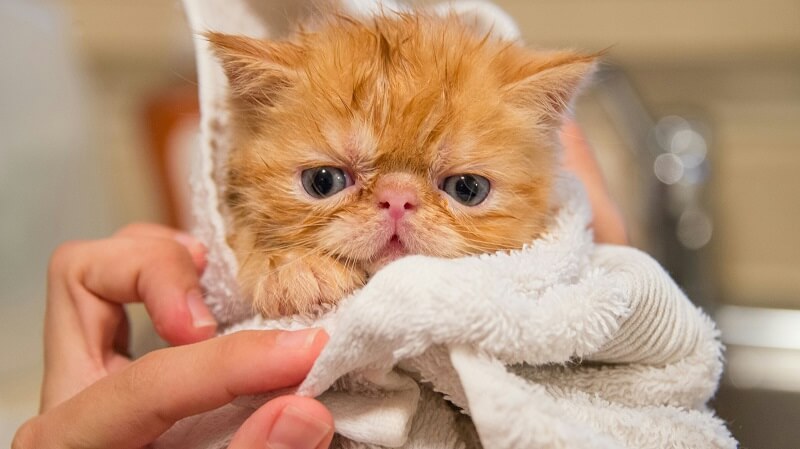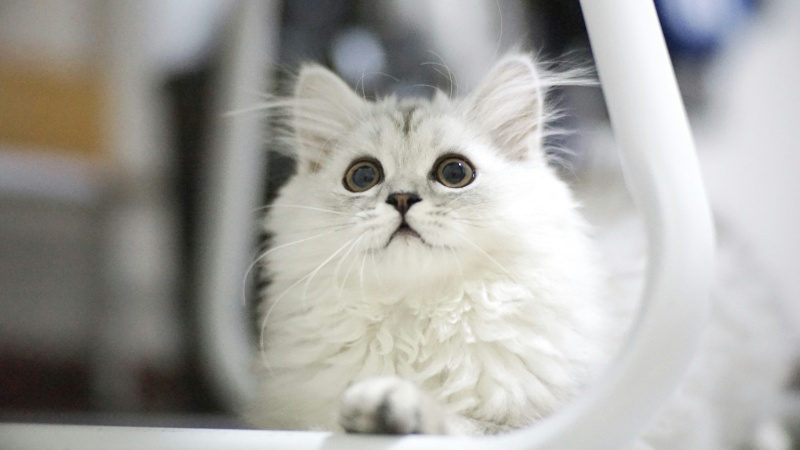
How To Craft A Cozy Cat Vest From Fabric Strips
Have you ever seen your feline friend lounging around and thought, “What could possibly make this picture more adorable?” The answer is simple: a cat

Cats naturally excel at grooming, yet there are times when they require additional assistance from their owners. In the event your feline friend is infested with fleas, a cat flea bath becomes essential.
The thought of bathing a water-averse cat can be daunting. Wondering how to bathe your cat when it detests water?
The key lies in gradually introducing them to the bath with lukewarm water, coupled with patience and soothing words.
The initial step in ensuring your cat remains tranquil is for you to maintain your own composure. Cats often mirror the emotions of their owners.
While staying serene doesn’t guarantee your cat won’t become slightly agitated when its feet touch the water, it definitely aids in the process.
Additionally, placing a calming diffuser in the bathroom can be beneficial. This device emits pheromones that signal to the cat it’s in a safe and secure environment.
Certain cats require time to understand that bathwater isn’t a threat. Begin by simply wetting his paws to slowly introduce him to the concept of bathing.
Another strategy is to have him in the bathroom while you bathe, familiarizing him with the sound of flowing water.
Reward him with treats when his paws become slightly wet. Consider floating a toy in the water, which might pique his curiosity and lead him to dip a paw in, realizing the water isn’t frightening.
While some cats will gradually grow accustomed to water, others may still require gentle encouragement and reassurance during an actual bath.
Ensure everything is prepared before starting your cat’s bath to avoid any mid-bath disruptions. Clip your cat’s nails a couple of days prior to the bath to minimize scratching.
Prepare multiple towels: one on the bathroom floor to absorb any water spillage, and another to gently dry your cat’s fur post-bath. Some owners place a towel or a rubber mat in the tub to give their cats better footing.
Brush your cat’s fur before bathing. Dealing with matted fur when wet can be challenging and painful while shampooing.
Keep the flea shampoo within easy reach. Cleansing Shampoo is an excellent option for cats. It eradicates fleas, ticks, and lice, and prevents new flea eggs from hatching for up to 30 days.
Cats generally remain more tranquil in warm, comfortable water. Ensure the water is not too hot to avoid discomfort, yet not so cool as to cause your cat to feel cold.
Many owners opt for bathing their cats in a regular bathtub with a shallow level of warm water, just high enough to reach the cat’s chest.
Alternatively, some use smaller plastic tubs within a sink or bathtub for a more contained bathing space. Have one filled with soapy water and another with clean water to thoroughly rinse off the flea treatment.
Depending on your chosen approach, having your cat wear a harness during the bath can induce calmness, particularly if it’s a slim design that doesn’t hinder the application of flea shampoo.
Cats often dislike abrupt movements, especially when they feel exposed during a bath. Bathe your cat gently and speak to him in a calming manner.
Avoid using a spray hose; instead, use your hand to softly scoop warm water onto your kitty. Gradually wet his fur down to the skin, being mindful to keep water and soap away from his eyes, ears, or nose.
Flea shampoo requires a good lather. Gently work it into your cat’s coat for three to five minutes, avoiding the eyes (your cat might enjoy this as a massage!). Carefully follow the shampoo’s instructions and don’t leave it on longer than recommended.
If the bathroom is secure and there are no hiding spots, you can briefly take your cat out of the tub to change the water.
If using small tubs, replenish the clean water with warm water to maintain a comfortable temperature. Ensure your cat doesn’t lick himself during this process. Then, thoroughly rinse off all the shampoo.
Post-bath, use a dry towel to blot his wet fur and remove excess water. Then let him air dry in a small, warm, draft-free room.
For cats who are resistant to baths, alternative flea control methods can be useful. Instead of traditional flea treatments, consider using a tactical cat harness, which can be helpful in managing your cat’s outdoor activities to reduce exposure to fleas.
This harness can be worn comfortably by your cat during supervised outdoor time, helping to limit their contact with flea-infested areas.
It’s also important to treat your home environment to prevent fleas from residing in carpets. Use carpet sprays, powders, or foggers to keep your living spaces flea-free.
If your cats spend time outdoors, even when wearing a tactical cat harness, it’s a good idea to treat your yard with flea prevention products.
Training a cat to accept wearing a harness is easiest when they are kittens, as they can learn to view it as a normal part of their routine.
However, if you’ve missed that early window, it’s still possible to train your adult cat to wear a tactical harness with patience, preparation, and a calm approach.
In summary, giving a cat flea bath requires patience and understanding, particularly when your cat dislikes water.
It’s essential to gradually introduce them to water, maintain a calm atmosphere, and use warm water to create a comfortable environment.
Preparing all necessary items beforehand, handling your cat gently during the bath, and using suitable flea treatment products are key.
For cats that resist bathing entirely, alternative flea control methods like spot-on treatments or harnesses can be effective.
Early training can make baths easier, but even with adult cats, a calm and patient approach can lead to successful bathing experiences.
FAQ: Can I use human shampoo for my cat’s flea bath?
Answer: No, human shampoo is not suitable for cats and can be harmful. Always use a cat-specific flea shampoo that’s designed to be safe and effective for feline skin and fur.
FAQ: How often should I give my cat a flea bath?
Answer: Flea baths should be given only as often as necessary, typically when you notice fleas on your cat. Over-bathing can dry out your cat’s skin. Always follow the flea shampoo’s guidelines or consult with your vet.
FAQ: Is it safe to bathe a pregnant or nursing cat with flea shampoo?
Answer: Special care should be taken with pregnant or nursing cats. Consult your veterinarian before using any flea treatment products, as some ingredients may not be safe for pregnant or nursing cats.
FAQ: What should I do if my cat has an adverse reaction to the flea bath?
Answer: If your cat shows signs of discomfort, itching, or skin irritation after a flea bath, rinse the shampoo off immediately and contact your vet. They may have a flea allergy or a reaction to the shampoo.
FAQ: Can regular bathing eliminate the need for other flea treatments?
Answer: Regular bathing alone is usually not enough to control a flea problem. It’s important to use a comprehensive approach, including flea treatments, environmental control, and preventative measures.


Have you ever seen your feline friend lounging around and thought, “What could possibly make this picture more adorable?” The answer is simple: a cat

The moment you consider a dog hunting vest for your adventurous companion, you’re stepping into a world where safety meets functionality. This vest is not

The concept of a dog cooling vest is a game-changer for pet owners looking to enhance their dog’s comfort during those relentless summer days. Imagine

When you first consider crafting a tactical dog vest, it’s not just about embarking on a fun DIY project; it’s about ensuring your furry companion’s

Have you ever seen your feline friend lounging around and thought, “What could possibly make this picture more adorable?” The answer is simple: a cat

The moment you consider a dog hunting vest for your adventurous companion, you’re stepping into a world where safety meets functionality. This vest is not

The concept of a dog cooling vest is a game-changer for pet owners looking to enhance their dog’s comfort during those relentless summer days. Imagine

When you first consider crafting a tactical dog vest, it’s not just about embarking on a fun DIY project; it’s about ensuring your furry companion’s
Secure and Empower, Walk Responsibly
Copyright © 2025pettacticalharness. All Rights Reserved.